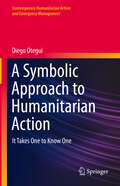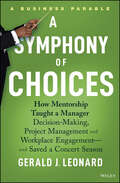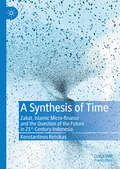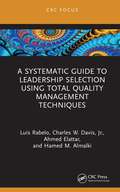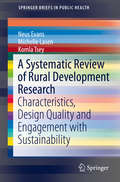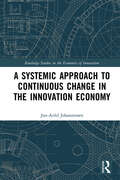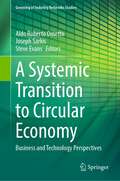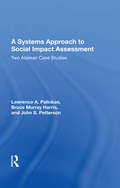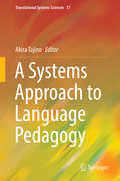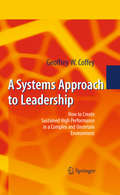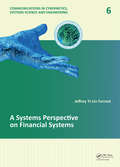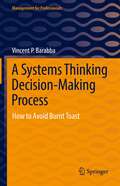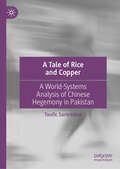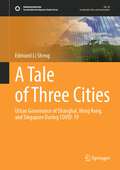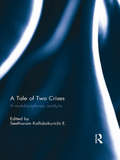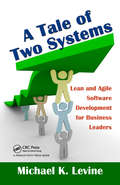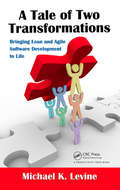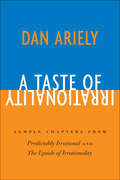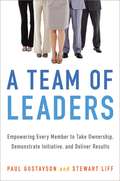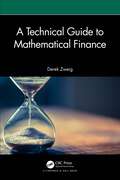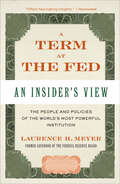- Table View
- List View
A Sweeping Vision: Real World Strategies for Observing Team Dynamics, Evaluating Outrageous Targets, and Developing Effective Interview Protocols
by Jay Barney Patricia Gorman Clifford"What I Didn't Learn in Business School" is a fictional account that follows new consultant Justin Campbell as he joins an elite team hired by a chemical firm to assess the potential of a newly developed technology. Consulting, as many recent MBA graduates learn, is more than analyzing data and cracking cases. In this chapter, Justin learns some important lessons about working with different personalities, developing plans for client interviews that yield revealing results, and weighing risk and reward to manage audacious goals. Authors Jay Barney and Trish Gorman Clifford demonstrate through Justin's struggles that in the real world, strategy development does not happen by analysis alone--it requires listening, sharing, and asking the tough, insightful questions that will help you grasp organizational complexities and determine the best course of action given the circumstances. This chapter was originally published as Chapter 7 of "What I Didn't Learn in Business School: How Strategy Works in the Real World."
A Symbolic Approach to Humanitarian Action: It Takes One to Know One (Contemporary Humanitarian Action and Emergency Management)
by Diego OteguiThis book aims to present an alternative view of humanitarian action. It adds to current conversations and dilemmas within the humanitarian sphere by departing from traditional views that consider humanitarian interventions as a concrete human activity aimed at providing relief to disaster victims. Much differently, it invokes the idea that humanitarian action is also a cognitive process. In this process, both humanitarians and disaster survivors alike, unknowingly, apply historically, societally, and culturally defined symbolic constructions to make sense of post-disaster information and to make decisions. In the specific case of humanitarian workers, these symbolic constructions influence how they understand their post-disaster reality, including how they relate to those they consider to be in pain or distress. This way of looking at humanitarian action builds upon a robust theoretical framework called Institutional Logics, which helps us identify and interpret how individuals make sense of their reality. So it brings the complex world of the individual into a discussion that generally considers the organization as the unit of analysis. Studying humanitarian action through this alternative lens makes it easy to see that objective and verifiable post-disaster information is a necessary but not a sufficient condition to design humanitarian interventions, let alone assess their value and benefits. A Symbolic Approach to Humanitarian Action: It Takes One to Know One aims to bridge the gap between research and practice in humanitarian action by translating academic knowledge into an accessible format that can be used by practitioners to improve their work on the ground.
A Symphony of Choices: How Mentorship Taught a Manager Decision-Making, Project Management and Workplace Engagement -- and Saved a Concert Season
by Gerald J. LeonardLearn how to make decisions in the face of increasingly complex and multifaceted challenges In A Symphony of Choices: How Mentorship Taught a Manager Decision-Making, Project Management and Workplace Engagement -- and Saved a Concert Season, workplace culture and strategy expert Gerald Leonard delivers a fascinating narrative following one Jerry Hall, the new Symphony Orchestra manager at a prestigious symphony concerned about the challenging plans for an upcoming season. In the book, you’ll watch Jerry connect with a former college professor and learn the skills necessary to successfully manage his way through these unprecedented times in his business and personal life. Does he have all skills necessary for effective decision-making and managing a major symphony’s portfolio of projects? Will his fear of succumbing to daunting challenges prevent him from succeeding? The author answers these questions, and more. You’ll also find: Hands-on strategies for decision-making and management you can implement today at your organization Methods for navigating an increasingly complex and interconnected environment Ways to apply subject-matter knowledge to your management even in the face of extraordinary personal challengesA necessary and hands-on resource for directors, managers, executives, and other business leaders, A Symphony of Choices will also earn a place on the bookshelves of practicing and aspiring leaders in athletic, academic, military, and other environments.
A Synthesis of Time: Zakat, Islamic Micro-finance and the Question of the Future in 21st-Century Indonesia
by Konstantinos RetsikasThis book is an anthropological investigation into the different forms the economy assumes, and the different purposes it serves, when conceived from the perspective of Islamic micro-finance as a field of everyday practice. It is based on long-term ethnographic research in Java, Indonesia, with Islamic foundations active in managing zakat and other charitable funds, for purposes of poverty alleviation. The book explores the social foundations of contemporary Islamic practices that strive to encompass the economic within an expanded domain of divine worship and elucidates the effects such encompassment has on time, its fissure and synthesis. In order to elaborate on the question of time, the book looks beyond anthropology and Islamic studies, engaging attentively, critically and productively with the post-structuralist work of G. Deleuze, M. Foucault and J. Derrida, three of the most important figures of the temporal turn in contemporary philosophy.
A Systematic Guide to Leadership Selection Using Total Quality Management Techniques
by Luis Rabelo Charles W. Davis, Jr. Ahmed Elattar Hamed M. AlmalkiThe old cliché states that not every manager is a leader, but the more important part of that sentiment is that to be a good manager, one has to be a good leader. This perception is because good managers do more than manage. They have to lead by inspiration, they have to lead by example, and they have to lead through the best times for their organizations as well as the absolute worst times. A Systematic Guide to Leadership Selection Using Total Quality Management Techniques identifies the application gap and presents a methodology based on Total Quality Management (TQM) to support the guidance of a process to select leadership (at any level of the organization). A modification to the House of Quality and a product of the Massachusetts Institute of Technology is presented and discussed as the core of a leader selection process. Two case studies are used to reinforce the concepts and applications. Finally, the book introduces some experiments for leadership development using virtual worlds and ends with a note for the future using the metaverse and digital twins for leadership. The book is intended for professionals and executives wanting to learn more about leader selection, engineering and business students, directors of human resources, and researchers in the field of leadership.
A Systematic Review of Rural Development Research: Characteristics, Design Quality and Engagement with Sustainability (SpringerBriefs in Public Health)
by Komla Tsey Neus Evans Michelle LasenRapid urbanisation, inequalities in income and service levels within and between communities, and population and economic decline are challenging the viability of rural communities worldwide. Achieving healthy and viable rural communities in the face of rapidly changing social, ecological and economic conditions is a declared global priority. As a result, governments all over the world, in both developed and developing countries, are now prioritizing rural and regional development through policies and programs aimed at enhancing the livelihoods of people living in rural regions. In recognition of the important roles that research can play in rural development, a range of systematic literature reviews have rightly examined key priorities in rural development including education, gender, economic development (especially agriculture), and health and nutrition (see Department for International Development [DFID], 2011). However, none of these works has systematically examined the extent to which rural development as a field of research is progressing towards facilitating sustainable change. This book evaluates trends in rural development research across the five continental regions of the world. Specifically, it assesses the total publication output relating to rural development, the types of publications, their quality and impact over the last three decades. Additionally, it evaluates the continental origins of the publications as well as the extent to which such publications engage with issues of sustainability. The aim is to determine whether the rural development field is growing in a manner that reflects research and policy priorities and broader social trends such as sustainability. Development policy makers, practitioners, those teaching research methods and systematic literature reviews to undergraduate and graduate students, and researchers in general will find the book both topical and highly relevant.
A Systemic Approach to Continuous Change in the Innovation Economy (Routledge Studies in the Economics of Innovation)
by Jon-Arild JohannessenUnpredictable and unforeseen, or black swan, events are occurring increasingly often, one such recent example is the coronavirus crisis of 2020. The Fourth Industrial Revolution, with its growing use of artificial intelligence, intelligent robots, intelligent informats and intelligent algorithms, may help us to confront these incidents but only if we can avoid the sector optimization logic of some forms of economic thinking. This book offers a multi-faceted presentation of the application of systemic thinking in non-standard situations, especially those created by the fourth industrial revolution. It develops models and mini theories to promote systemic thinking at a time when cascades of innovations are entering the economy, while at the same time black swan events are occurring and disrupting social systems. It takes a critical look at how organizations and social systems have chosen to organize themselves to develop systems that prioritize high performance, by focusing on cost-cutting and maximizing profits, instead of on preparedness elasticity and resource slack. The consequences of this kind of organizational streamlining becomes evident only when the ‘black swans’ loom. The author discusses how individuals and society can develop the resilience needed to deal with these incidents. He asserts that there are three central social mechanisms that can help us understand how social systems work and how they are interconnected: time-lag, threshold value, and feedback. These three concepts can help us to understand how changes occur in non-linear systems; for instance, how small changes at the micro level can lead to large changes at the macro level. This book will be of interest to researchers, academics and students in the fields of economics, finance, business and industry.
A Systemic Transition to Circular Economy: Business and Technology Perspectives (Greening of Industry Networks Studies #12)
by Steve Evans Joseph Sarkis Aldo Roberto OmettoThe book will explore, using multiple perspectives from multiple contributors, two main aspects for circular economy (CE) business and technology (B&T): systems and value perspectives. Going beyond a linear-economic perspective--the traditional perspective--CE needs to develop intentional and integrated paths to help restore physical resources and regenerate the functions of natural and anthropic systems, creating greater economic and social opportunities, with environmentally positive outcomes. Whether this is feasible and possible within the context of CE and B&T is something that will be central to the contributions made in this book. A major objective of the book is to deliver practical and fundamental knowledge of B&T CE insights combining a systems perspective and value creation for socio-technical innovation leading to sustainable transitions and effective transformations. Based on those key aspects, the book is structured in two parts, one from a more theoretical and conceptual basis in Part 1, and a more applied perspective in Part 2. The chapters in Part 1 are presented through the lens of business and systems transitions. In Part 2, the chapters present the opportunities and the journeys from real case studies of companies engaged in circular business strategies, processes, practices, and technologies.
A Systems Approach To Social Impact Assessment: Two Alaskan Case Studies
by Lawrence A. Palinkas Bruce Murray Harris John S. PettersonThis book provides two case studies that demonstrate the use of systems analysis to forecast the often far-reaching consequences of government policies and economic development for the social relations and cultural values of different communities. The case studies examine the potential effects of oil development in two rural Alaskan communities, co
A Systems Approach to Language Pedagogy (Translational Systems Sciences #17)
by Akira TajinoThis volume represents the first attempt in the field of language pedagogy to apply a systems approach to issues in English language education. In the literature of language education, or more specifically, second or foreign language learning and teaching, each topic or issue has often been dealt with independently, and been treated as an isolated item. Taking grammar instruction as an example, grammatical items are often taught in a sequential, step-by-step manner; there has been no “road map” in which the interrelations between the various items are demonstrated. This may be one factor that makes it more difficult for students to learn the language organically. The topics covered in this volume, including language acquisition, pedagogical grammar, and teacher collaboration, are viewed from a holistic perspective. In other words, language pedagogy is approached as a dynamic system of interrelations. In this way, “emergent properties” are expected to manifest. This book is recommended for anyone involved in language pedagogy, including researchers, teachers, and teacher trainers, as well as learners.
A Systems Approach to Leadership: How to Create Sustained High Performance in a Complex and Uncertain Environment
by Geoffrey Coffey"A Systems Approach to Leadership" (SAL) is a methodology for creating sustained high performance in conditions of high complexity and uncertainty. SAL places the latest developments in Systems Science into an actionable method for use by everyday leaders. It enables leaders to develop themselves and their organisation (or part of it) quickly and effectively to achieve a competitive advantage in a complex and uncertain world. SAL consists of an integrated framework with an overall strategy of whole system development. Central to the framework is a practical method which can be used by any leader at any organisational level. Supporting the framework are a range of systems approaches and a set of foundational assumptions. SAL has been carefully researched and refined in extensive field tests where it typically delivers outcomes well above expectations.
A Systems Perspective on Financial Systems (Communications in Cybernetics, Systems Science and Engineering)
by Jeffrey Yi-Lin ForrestThis book is devoted to a systems-theoretical presentation of the main results of applying the systemic yoyo model and relevant analytical tools to the topics of money and financial institutions. The author presents the main concepts and results of the subject matter in the language of systems science, which has in the past century prompted revolut
A Systems Thinking Decision-Making Process: How to Avoid Burnt Toast (Management for Professionals)
by Vincent P. BarabbaThis book illustrates how to access the right information for making the best decisions during turbulent times. It is written from an experienced-based perspective that is beneficial for those looking for the development and improvement of the decision-making process. The approach is centered on the author’s experience in developing and implementing effective and efficient approaches to decision-making in business and government. Based on those experiences, this book provides insights into how to improve the decision making process of your organization, whether it be large or small. For decision makers and those providing market information for making decisions, this book provide guidelines for a framework which includes systems thinking. For those interested in change management and corporate governance, the book presents examples where it was done well and some examples where it was not and the ensuring consequences. Praise for Systems Thinking Decision-Making Process… "This is an absolutely incredible book by a distinguished practitioner. The range of knowledge and experience that Vince Barabba has had is astounding. I urge everyone who is interested in complex, messy problems to read this amazing book.” --Ian I. Mitroff “…Vince has masterfully blended the art of organizational respect with the science of data inquiry to drive change and realize strategic vision. A master storyteller, he does not just teach, his book brings his learnings to life in a meaningful way that if carefully listened to, can change the course of a career.” -- Paul D'Alessandro Principal, Health Industries, PwC US “In his latest book, Vince Barabba integrates his vast knowledge from 50 years of dedicated work in both the public and private sectors in order to provide leaders with an actionable framework for radically improving how their organizations collect and use information to make the best decisions for all the wicked messes that now appear in our global village… This book can save your company from living in the dark with false assumptions about all your key stakeholders.” -- Ralph H. Kilmann, Ph.D. CEO, Kilmann Diagnostics Co-Author, The Thomas-Kilmann Conflict Mode Instrument (TKI) "Absorbing just a few of the many smart ideas in this book will make you a better leader and decision maker. Thinking systemically about how the hard-earned lessons from Vince Barabba’s brilliant career apply to your enterprise could make you a great one." — Chunka Mui Co-Author, A Brief History of a Perfect Future and Billion Dollar Lessons “…if you are interested in ‘thinking in systems,’ this book is for you. The ‘On Star’ story demonstrates to you how the initial product-centered thinking was proselytized to ‘thinking in systems’." -- John Pourdehnad Visiting Professor, IESE Business School and Faulty of Systems Leadership, Thomas Jefferson University “In writing Systems Thinking Decision-Making Process: How to Avoid Burnt Toast, Vince Barabba is addressing the limits of knowledge management systems which enable ‘organizations as usual’ to share best practices on how to scrape toast faster and cheaper… The examples shared by Vince, from his first-hand experiences in corporate America or his services as a marketing consultant, contribute invaluable clarity to his goal of providing a “sketch of an Inquiry Center Learning and Support System” for those with the ambition to lead efforts to work smarter, not harder, firmly against the grain of ‘organizations as usual’…” -- Bill Bellows, Ph.D., President, InThinking Services Adjunct Professor, California State University, Northridge and Southern Utah University Advisory Council Member and Former Deputy Director, The W. Edwards Deming Institute® “In his ‘last book’, Vince weaves the experiences and learning of a lifetime into whole cloth of insight
A Tailored Presentation: Real World Strategies for Anticipating Resistance to Recommendations, Making High Impact Presentations, and Aligning Organizational Structure with Strategic Objectives
by Jay Barney Patricia Gorman CliffordThis chapter was originally published as Chapter 14 of "What I Didn't Learn in Business School: How Strategy Works in the Real World."
A Tale Of Two Capitalisms: Sacred Economics In Nineteenth-century Britain
by Supritha RajanNo questions are more pressing today than the ethical dimensions of global capitalism in relation to an unevenly secularized modernity. A Tale of Two Capitalisms offers a timely response to these questions by reexamining the intellectual history of capitalist economics during the nineteenth century. Rajan's ambitious book traces the neglected relationships between nineteenth-century political economy, anthropology, and literature in order to demonstrate how these discourses buttress a dominant narrative of self-interested capitalism that obscures a submerged narrative within political economy. This submerged narrative discloses political economy's role in burgeoning theories of religion, as well as its underlying ethos of reciprocity, communality, and just distribution. Drawing on an impressive range of literary, anthropological, and economic writings from the eighteenth through the twenty-first century, Rajan offers an inventive, interdisciplinary account of why this second narrative of capitalism has so long escaped our notice. The book presents an unprecedented genealogy of key anthropological and economic concepts, demonstrating how notions of sacrifice, the sacred, ritual, totemism, and magic remained conceptually intertwined with capitalist theories of value and exchange in both sociological and literary discourses. Rajan supplies an original framework for discussing the ethical ideals that continue to inform contemporary global capitalism and its fraught relationship to the secular. Its revisionary argument brings new insight into the history of capitalist thought and modernity that will engage scholars across a variety of disciplines.
A Tale of Rice and Copper: A World-Systems Analysis of Chinese Hegemony in Pakistan
by Toufic SarieddineThis book explores Chinese investments in, and cooperation with Pakistan under the Belt and Road Initiative (BRI). Analyzing the BRI’s Pakistan limb, the China-Pakistan Economic Corridor (CPEC), the book illustrates the hegemonic tug of war between Washington and Beijing in Pakistan. There, China demonstrates its capacity to imprint its modus operandi onto peripheries through channels such as institutions, law, and currency, its economic dominance in production, trade, and finance through the control of quasi-monopolies on high-yielding economic processes (especially renewables and hard infrastructure) fostering trade surpluses which ultimately establish a net stream of inward revenue from Pakistan-as-periphery, military dominance to safeguard these revenue streams and furnish security to Islamabad, and cultural hegemony to socialize it at the level of the individual through media cooperation, state-wide language courses, and foreign education. The book addresses the need for an in-depth and comprehensive examination of a state under the Belt & Road Initiative, and will be of interest to scholars of China, South Asian affairs, international relations generally, and of geopolitics.
A Tale of Three Cities: Urban Governance of Shanghai, Hong Kong, and Singapore During COVID-19 (Sustainable Development Goals Series)
by Edmund Li ShengThe proposed book presents the cutting-edge research on the urban development of three cities: Shanghai, Hong Kong, and Singapore. By comparing their responses to the COVID-19 pandemic from an international political economic perspective, this book examines the commonalities and differences in urban governance in these three widely recognized and well-developed Asian cities with outward-oriented economies through the lens of world-systems theory and related theories of historicism. These cities are all generally considered to be under authoritarian regimes, but there are substantial differences in their social systems, rules of law and justice, and administrative structures. In the context of globalization, the cities are competing on a more even playing field. In addition, city governments worldwide are increasingly pursuing growth, land markets, urban regeneration, and large-scale public projects. With the advent of globalization, urban development is gradually changing from the past crude model of spatial expansion and land finance to a more refined model of socioeconomic development driven by industrial upgrading and enhanced consumption. However, cities’ political and economic contexts and governance systems vary greatly. Unsurprisingly, given their differences, the three cities of Shanghai, Hong Kong, and Singapore demonstrated varied responses to the COVID-19 pandemic. This book discusses the efforts of these governments to address and reduce the spread of COVID-19 as well as how national responses to the pandemic outbreak were influenced by global dynamics, geopolitics, and each nation’s particular historical context.
A Tale of Two Crises: A Mutidisciplinary Analysis
by Seetharam Kallidaikurichi E.Some analysts looked at the 1997/98 East Asian crisis not as one crisis but as a combination of crises, beginning with a crisis of confidence and evolving into a currency crisis, a financial crisis, an economic crisis, a social crisis and a political crisis. This book is a multidisciplinary study of financial crises, in particular, the Asian crisis of 1997 and the more recent global financial crisis of 2008. Looking at financial crises not as one crisis, but as a combination of crises beginning with a crisis of confidence, this study steps out of the traditional mould and examines financial crises from novel perspectives. The book highlights that since the origin of a financial crisis is a confidence crisis, either in the whole economy or a particular sector, the Asian and recent global crises could have backward and forward linkages to political regimes and institutions, culture and tradition, the role of the media, society and societal evolution and development processes of regulatory regimes. Through contributions by authors in fields ranging from sociology and political science, media and Islamic banking, to law and regulation, this study adopts a broad framework for understanding financial crises, and sheds light on the interwoven and complex structures and often overlooked aspects which contribute to the holistic understanding of this topic.
A Tale of Two Systems: Lean and Agile Software Development for Business Leaders
by Michael K. LevineThis business parable reviews two different systems development projects. One project was an abject, expensive failure, while the other succeeded in creating a major new revenue stream, bringing in new customers. By reviewing the tales of these two systems, readers will develop a better understanding of what works and what doesn‘t when it comes to
A Tale of Two Transformations: Bringing Lean and Agile Software Development to Life
by Michael K. LevineThere are many books that seek to explain Lean and Agile software that offer theory, techniques, and examples. Michael Levine’s first book, A Tale of Two Systems, is one of the best, synthesizing Lean manufacturing and product development with agile software concepts in an engaging business novel. However, there has been precious little practical guidance for those seeking to change existing organizations to become Lean and Agile, until now. Mr. Levine has followed the successful approach of A Tale of Two Systems, telling two simultaneous intertwined and contrasting stories, to bring organizational transformation to life. Mary O’Connell and James "Wes" Wesleyan, recently engaged to be married, share a commitment to Lean and Agile Software. They have recently become leaders in two very different companies – one, stuck in a slow-moving, unresponsive, process-driven quagmire of a software culture; the other, struggling through the chaos of a sales-driven, process-less swirl. Together with their wise mentor, Neville Roberts, they identify two approaches to making needed changes: Drive People (a top-down approach focused on processes and tools), and People Driven (an enablement approach focused on people and organizations). Mary and Wes evaluate their situations and choose approaches that best fit for them, and the transformations commence. A Tale of Two Transformations differs from many information technology books by grappling with all the complexities of our organizations: the people, the politics, the financials, the processes – in short, the culture from which our Lean and Agile journeys must begin. The change model presented in the flow of the stories is generally applicable, and can help anyone thinking about how to improve their organization.
A Taste of Irrationality: Sample chapters from Predictably Irrational and Upside of Irrationality
by Dan ArielySample chapters from Predictably Irrational and Upside of Irrationality. Predictably Irrational Why do our headaches persist after we take a one-cent aspirin but disappear when we take a fifty-cent aspirin? Why do we splurge on a lavish meal but cut coupons to save twenty-five cents on a can of soup? When it comes to making decisions in our lives, we think we're making smart, rational choices. But are we? In this newly revised and expanded edition of the groundbreaking New York Times bestseller, Dan Ariely refutes the common assumption that we behave in fundamentally rational ways. From drinking coffee to losing weight, from buying a car to choosing a romantic partner, we consistently overpay, underestimate, and procrastinate. Yet these misguided behaviors are neither random nor senseless. They're systematic and predictable-making us predictably irrational. Upside of Irrationality The provocative follow-up to the New York Times bestseller Predictably Irrational Why can large bonuses make CEOs less productive? How can confusing directions actually help us? Why is revenge so important to us? Why is there such a big difference between what we think will make us happy and what really makes us happy? In his groundbreaking book Predictably Irrational, social scientist Dan Ariely revealed the multiple biases that lead us into making unwise decisions. Now, in The Upside of Irrationality, he exposes the surprising negative and positive effects irrationality can have on our lives. Focusing on our behaviors at work and in relationships, he offers new insights and eye-opening truths about what really motivates us on the job, how one unwise action can become a long-term habit, how we learn to love the ones we're with, and more. Drawing on the same experimental methods that made Predictably Irrational one of the most talked-about bestsellers of the past few years, Ariely uses data from his own original and entertaining experiments to draw arresting conclusions about how-and why-we behave the way we do. From our office attitudes, to our romantic relationships, to our search for purpose in life, Ariely explains how to break through our negative patterns of thought and behavior to make better decisions. The Upside of Irrationality will change the way we see ourselves at work and at home-and cast our irrational behaviors in a more nuanced light.
A Team Effort: Real World Strategies for Justifying Vertical Integration, Considering Joint Ventures, and Understanding Organizational Dynamics
by Jay Barney Patricia Gorman Clifford"What I Didn't Learn in Business School" is a fictional account that follows new consultant Justin Campbell as he joins an elite team hired by a chemical firm to assess the potential of a newly developed technology. At the opening of this chapter, Justin realizes that the work he has been doing alone on the new project overlaps significantly with the work that his colleagues have done. While attempting to crack the strategy case on his own, he has failed to leverage the value of his team. Through Justin's struggles, authors Jay Barney and Trish Gorman Clifford underscore the virtues of teamwork as Justin and his colleagues explore the potential of vertical integration and joint ventures as strategic options for their client. This chapter was originally published as Chapter 9 of "What I Didn't Learn in Business School: How Strategy Works in the Real World."
A Team of Leaders: Empowering Every Member to Take Ownership, Demonstrate Initiative, and Deliver Results
by Stewart Liff Paul GUSTAVSONThe fresh approach taught in this indispensable guide will transform passive groups of disparate people into the effective teams of leaders you didn&’t know was possible to have.Every team needs a leader, but why do we often think that means the appropriate workplace team needs to consist of one gem of a worker complemented with a bunch of obedient order-takers and yes men? What if the complementary fits between the team members were not with how well they performed the tasks handed down to them but with how they all used their unique strengths to share knowledge, push the envelope, and lead together?The authors behind A Team of Leaders explain how the key to your company&’s success is creating successful teams of leaders combining their individual talents and strengths into a single, unstoppable driving force.The proven principles and techniques within these invaluable pages include:The Five-Stage Team Development Model that maps the transition from traditional to self-directed teamsBest practices in team process designA Team Value Creation Tool that allows members to appreciate the significance of what they contribute each dayVisual Management and moreA Team of Leaders shows you how to design systems within your organization and management procedures that nurture the leadership potential of every employee, not just the ones they ear-marked as having potential for promotion.
A Technical Guide to Mathematical Finance (Chapman and Hall/CRC Financial Mathematics Series)
by Derek ZweigA Technical Guide to Mathematical Finance covers those foundational mathematical topics most important to an aspiring or professional quant. The text goes beyond a simple recitation of methods and aims to impart a genuine understanding of the fundamental concepts underpinning most of the techniques and tools routinely used by those working in quantitative finance.Features Suitable for professional quants and graduate students in finance, and mathematical/quantitative finance “Concept Refreshers” used throughout to provide pithy summaries of complex topics Step-by-step detail for formal proofs and mathematical descriptions
A Term at the Fed: An Insider's View
by Laurence H. MeyerAs a governor of the Federal Reserve Board from 1996 to 2002, Laurence H. Meyer helped make the economic policies that steered the United States through some of the wildest and most tumultuous times in its recent history. Now, in A Term at the Fed, Governor Meyer provides an insider's view of the Fed, the decisions that affected both the U.S. and world economies, and the challenges inherent in using monetary policy to guide the economy.When Governor Meyer was appointed by President Clinton to serve on the Federal Reserve Board of Governors in 1996, the United States was entering one of the most prosperous periods in its history. It was the time of "irrational exuberance" and the fabled New Economy. Soon, however, the economy was tested by the Asian financial crisis, the Russian default and devaluation, the collapse of Long-Term Capital Management, the bursting of America's stock bubble, and the terrorist attacks of 9/11.In what amounts to a definitive playbook of monetary policy, Meyer now relives the Fed's closed-door debates -- debates that questioned how monetary policy should adapt to the possibility of a New Economy, how the Fed should respond to soaring equity prices, and whether the Fed should broker the controversial private sector bailout of LTCM, among other issues. Meyer deftly weaves these issues with firsthand stories about the personalities involved, from Fed Chairman Alan Greenspan to the various staffers, governors, politicians, and reporters that populate the world of the Fed.Since the end of his term, Meyer has continued to watch the Fed and the world economy. He believes that we are witnessing a repetition of some of the events of the remarkable 1990s -- including a further acceleration in productivity and perhaps another bull market. History does not repeat itself, yet Meyer shows us how the lessons learned yesterday may help the Fed shape policy today.

